April 25, 2014
Air Date: April 25, 2014
FULL SHOW
SEGMENTS

Dangerous Work On Mt. Everest
View the page for this story
Western climbers rely on local Sherpa mountaineering experts to summit Mount Everest, but a recent deadly avalanche swept away 16 of them and the accident threatens the lucrative climbing season. Grayson Schaffer, senior editor at Outside Magazine, tells host Steve Curwood that many are questioning the ethics of subjecting Sherpas to such peril simply for the thrill of reaching the top of the world’s highest mountain. (06:50)

Flea Collar Ban To Protect Toddlers
View the page for this story
The EPA has banned certain flea and tick collars for cats and dogs because young children touching their pets can get exposures to unhealthful amounts of pesticides. The move came in response to lawsuits filed by the Natural Resources Defense Council. NRDC Senior Scientist Miriam Rotkin-Ellman tells host Steve Curwood there are safer alternatives. (05:50)
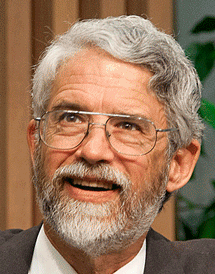
Climate and the President's Science Advisor
View the page for this story
President Obama’s science advisor John Holdren joins host Steve Curwood to discuss the National Climate Assessment draft report and what to expect from the United States at the international climate talks in Paris next year. (07:20)
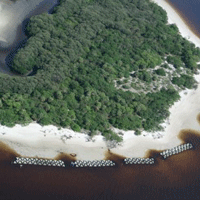
BP Says Gulf Cleanup Over
View the page for this story
Oil from the Deepwater Horizon disaster still washes up on beaches after storms, but BP recently announced that their active cleanup phase has come to an end. But Audubon bird specialist Melanie Driscoll tells host Steve Curwood that oil keeps coming ashore and we’re only beginning to understand the impact of the spill on the gulf ecosystem. (11:20)
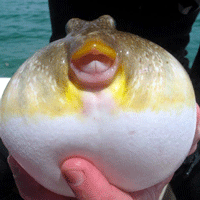
Update - Fighting to Protect an Ancient Underwater Forest
View the page for this story
Ten years ago, Hurricane Ivan uncovered an ancient Cypress forest on the bottom of the Gulf of Mexico. Ben Raines of the Weeks Bay Foundation in Alabama tells host Steve Curwood that scientists and conservationists are studying the forest to learn about sea level rise and fighting to protect the wood from salvage companies. (06:25)

Beyond the Headlines
In this week’s trip beyond the headlines Peter Dykstra tells host Steve Curwood learn about tourism in Chernobyl and commemorates the publication of a famous Newsweek article on global cooling that has inspired climate change deniers for decades. (04:50)
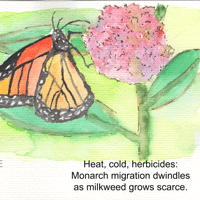
Earth Day Haiku
View the page for this story
We hear from a few of our listener poets in response to a shout out for environmental haiku in honor of earth day. (02:55)
Show Credits and Funders
Show Transcript
Dangerous Work On Mt. Everest

Sherpa Mountaineers on the Roof of the World (Photo: Grayson Schaffer/ Outside Magazine)
CURWOOD: From the Jennifer and Ted Stanley Studios in Boston and PRI, this is Living on Earth. I’m Steve Curwood. To scale the highest mountain in the world was once only possible for the most skilled and brave climbers, but today just about any fit person with enough money can summit Mount Everest. Those ascents wouldn't be possible without help from the Sherpas, native to the mountains, but a recent deadly accident that swept away 16 of them may disrupt the entire climbing season for 2014. As we record this, some two-thirds of the Sherpas are refusing to climb what is becoming an increasingly dangerous peak as a warming world speeds the melting of glaciers. We're joined now from Kathmandu, Nepal, by Grayson Schaffer, Senior Editor and Staff Writer for Outside Magazine. Welcome to LOE.
SCHAFFER: Thanks for having me, Steve.
CURWOOD: Tell me about some of the Sherpas you’ve met in Nepal. What’s their job?

(Grayson Schaffer/ Outside Magazine)
SCHAFFER: Well, the job is extremely physical. All of the guys that do this are wiry and incredibly strong. They need to be able to carry an 80-pound backpack up through the Khumbu icefall which is near 2,000 vertical feet starting at 17,600 feet going through about 19,500 feet, and they do up to 10 or 20 laps through this thing each season. It’s incredibly dangerous work, very physical, and they basically have to have a lot of fortitude to be able to do that many laps and keep going day after day.
There have been a couple of studies that have shown that there definitely is a genetic propensity for Sherpas to be able to use what available oxygen there is near the summit of Everest much more efficiently that what westerners are able to use. For the most part, these guys are in a league of their own. They’re basically able to do a lot more work than most westerners at any given altitude.

(Grayson Schaffer/ Outside Magazine)
CURWOOD: Now, Grayson, I understand you’ve been up at least a good ways up Mount Everest in that territory. Tell me what it’s like up there.
SCHAFFER: Well, I’ve been well into the Khumbu icefall, and it’s this eerie sort of place where these guys were killed where it seems very quiet, but there’s this sort of low background rumble where you can hear this sort of clicking and popping and things are constantly shifting underneath you, and the Khumbu icefall is this sort of hanging glacier, essentially this sort of river of ice that’s tumbling down the side of the mountain, and so it’s actually moving constantly, and you have these huge teetering blocks, you know, apartment-sized blocks of ice that are constantly shifting, and above it all you have the west shoulder of Everest on one side, and Nuptse, which is a 7,000-meter peak on the other side which are also sheets of ice and are constantly sending avalanches down on the route. One of the other problems that you get with warming temperatures is that the ice melts out to rock. Typically, the rocks and cobbles and boulders are sort of cemented into the mountain, and when it gets really warm, like we saw in 2012, these rocks will melt out and start tumbling down like missiles. And I heard a number of reports from people who would hear suitcase-sized boulders whistling by them. There were a number of Sherpas who were hit and injured, and some even critically injured by rockfall that was due to melting ice.
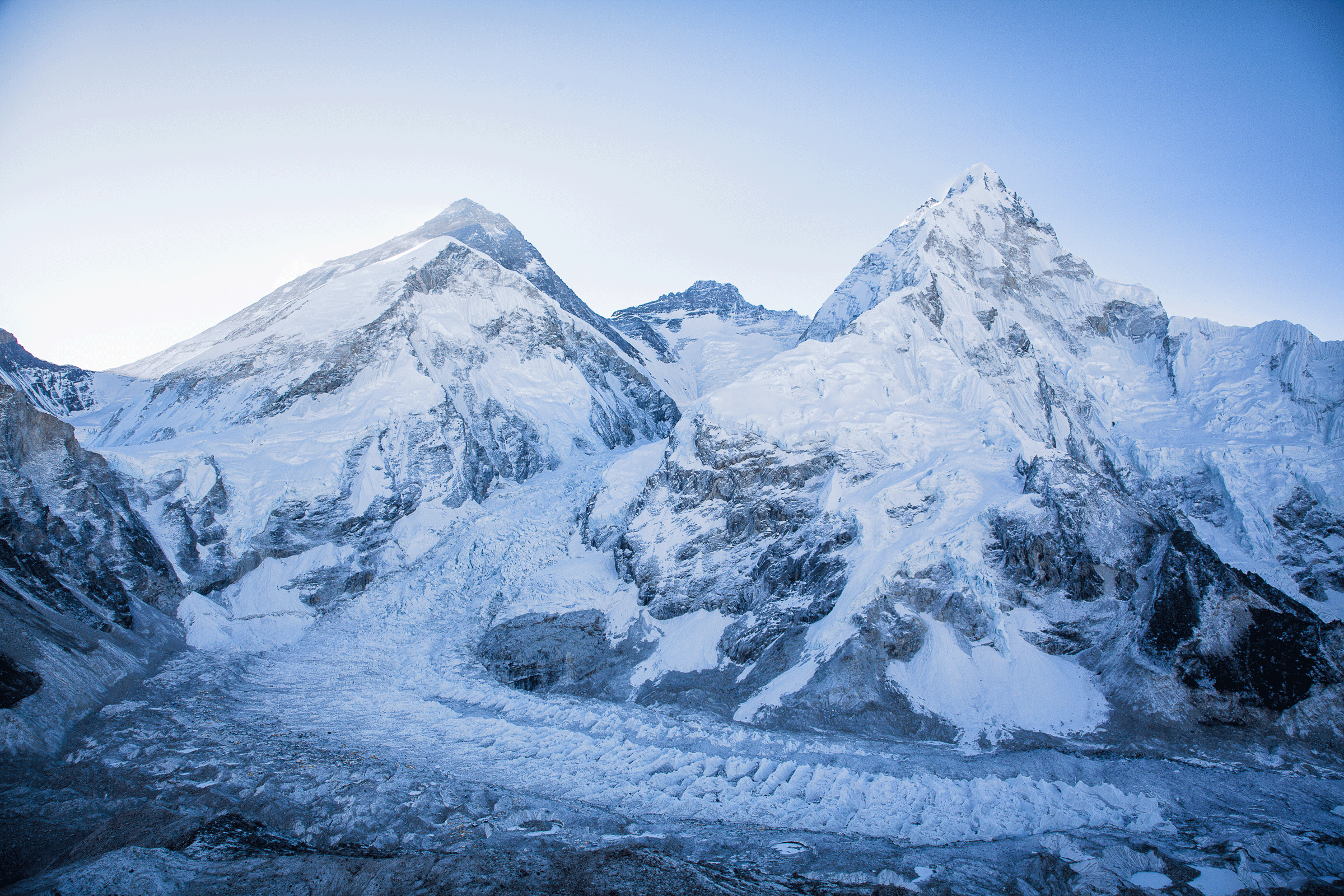
(Grayson Schaffer/ Outside Magazine)
CURWOOD: It’s obviously dangerous work. How dangerous is it relative to other dangerous occupations?
SCHAFFER: We know that one percent of people who leave base camp and head for the summit are probably not going to come back. And even though the Sherpas are probably more capable, more genetically advantaged to climbing, the fact that they’re spending so much time in the shooting gallery there, it exposes them to much greater risk. If you look at something like an actuarial table and you compare the chance of dying working as a Sherpa, it ends up being more dangerous than working as an Alaskan bush pilot, more dangerous than being a commercial fisherman like on The Deadliest Catch and probably even more dangerous than being a soldier in the US military. It’s really among the most dangerous occupations I think you can have.
CURWOOD: And it’s not just death by avalanche that puts them in peril. I was surprised to read in your articles that there are a lot of other health complications associated with the work. Can you tell me about that please?
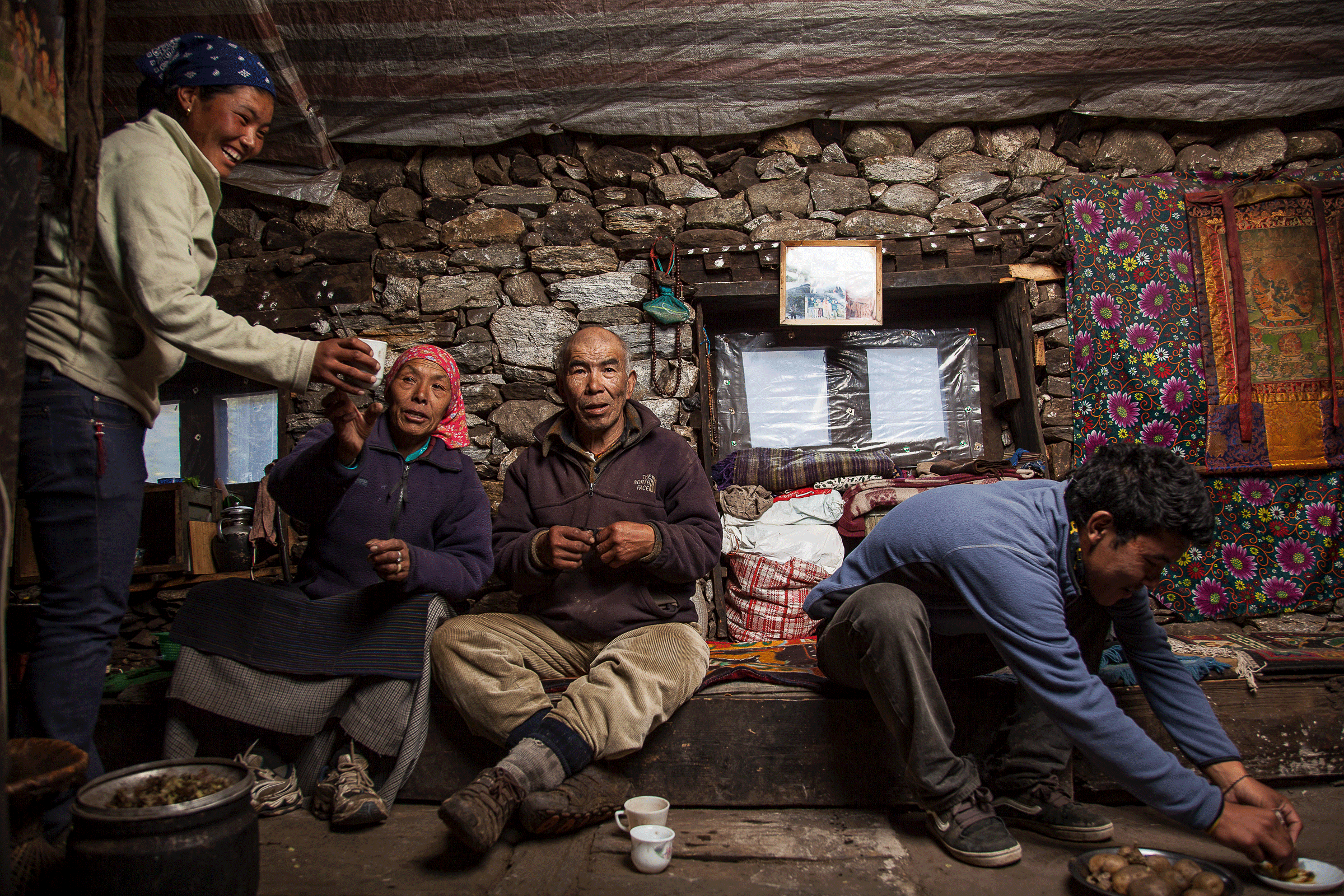
(Grayson Schaffer/ Outside Magazine)
SCHAFFER: Yes, that was one of the things I was really surprised to find that when I went looking in 2012, when I went in the fall trying to meet people who had lost their primary wage earners in the mountains, that I found not only a number of widows and children who had lost their fathers, but also a number of disabled men who had suffered a stroke. I think the medical evidence is still inconclusive on whether there’s actually a link between stroke and high altitude but certainly, anecdotally, it seems like it happens far more often to young fit men who ordinarily would have low risk for stroke, and in addition to that, you still have this sort of standard high-altitude ailments like high altitude pulmonary edema and cerebral edema, and these are both where your brain and your lungs begin leaking fluid which can become life-threatening extremely quickly if you don’t get down to lower altitude.
CURWOOD: Now, I know hikers can spend a lot of money to summit Mt. Everest. How much of that goes to the Sherpas that make it possible?

(Grayson Schaffer/ Outside Magazine)
SCHAFFER: The way that the sort of economy of Everest breaks down, a permit to climb Everest costs about $10,000 per person. That gets factored into the price that an outfitter charges you, which is typically between about $30,000 and $100,000. The sherpas will typically make between $2,000 and $6,000 per three-month season, which may not seem like a lot of money for somebody from the US, but is, in fact, eight to ten times what the average person in Nepal makes.
CURWOOD: Grayson, some would criticize what’s going on at Everest as being a very expensive theme park. I mean, if you look at the dark side of this, part of the thrill for the thrill-seekers is that, “Hey, I was on that expedition...a couple of people died, but I made it out.”

(Grayson Schaffer/ Outside Magazine)
SCHAFFER: Yes, and people ask me this every time one of these things happen. They say, "Now that this tragedy happened do you think fewer people will go?" And I say, "No, just the opposite. Every time there's one of these tragedies, in fact, more people go.” And I think, it’s just what you’re talking about. The danger is part of the allure. I mean if it were safe, why bother?"
CURWOOD: So how ethical is it for westerners to continue extreme hikes like Everest given the danger it presents for the Sherpas?
SCHAFFER: It’s not just something you can explain to others even if you can explain it to yourself, you know, why you’re doing this and why you’re putting these people at risk. Normally, when people do really dangerous jobs, it’s for things that society deems necessary like building bridges and dams and going to fight wars and that sort of thing, not taking people up a mountain so that they can have a look around.
CURWOOD: Grayson Schaffer is Senior Editor and Staff Writer at Outside Magazine. Thanks so much for taking the time with me today.
SCHAFFER: Well, thanks for having me.
Related link:
Outside Magazine: The Value of a Sherpa Life
Flea Collar Ban To Protect Toddlers

The NRDC logo (Courtesy of the NRDC)
CURWOOD: Spring brings blooming flowers, song birds and a fresh crop of fleas and ticks for our cats and dogs. Many people use pesticide-containing flea collars on their pets, but the EPA is now banning some of those collars because young children who snuggle up to their pets can get exposed to unhealthful amounts of the pesticides. The ban comes after eight years of litigation brought by the Natural Resources Defense Council to force the EPA to act. We called up Miriam Rotkin-Ellman, a Senior Scientist at NRDC to tell us about the ban and wiser choices for parents and pet owners. Welcome to the Living on Earth, Miriam.
ROTKIN-ELTMAN: Nice to be here.
CURWOOD: Give me the basics here. What’s the problem with flea collars?
ROTKIN-ELLMAN: We’re concerned there are pesticides that are extremely toxic for kids used in flea collars, and flea collars are designed to work by spreading that pesticide on the pet, and when kids come in contact with their pet which they do on a daily basis, they come into contact with that very toxic pesticide.
CURWOOD: So talk to me about these two chemicals. What are the problems with them as far as science knows?
ROTKIN-ELLMAN: So there are two different pesticides that are part of related classes of pesticides. So tetrachlorvinphos is a kind of pesticide that’s called an organophosphate. And over the last 15 years or so, there’s mounting evidence that organophosphates can interfere with the developing brain so that prenatal exposures and early life exposures to this pesticide can result in delays in motor development, loss of IQ points, or neurobehavioral problems such as Attention Deficit Hyperactivity Disorder. So this class, organophosphates, has been linked to all those different problems. The second pesticide, which is propoxur, is part of a related class of chemicals called carbamates, and unfortunately, it also has many of the same toxic characteristics. Both of these are readily available still, unfortunately, on the shelves.
CURWOOD: So what has EPA decided to do about these flea collars?
ROTKIN-ELLMAN: EPA took the right action on porpoxur last month in March, and issued a cancellation order. Unfortunately, they gave the manufacturers of these flea collars a pretty sweet deal, and allowed for a really long phase-out period. That phase-out period means the companies can keep making these flea collars despite the fact that EPA found them to be unsafe for children, and also, they can continue to be sold for up to two years to retailers, and then retailers can sell them indefinitely. Now, the other pesticide that we’re worried about, tetrachlorvinphos, the Environmental Protection Agency has been completely silent. We have not received any notification, and that’s why we’re continuing to pursue our court case and hoping that the court can help us get a timeline from EPA and help move it in the right direction as well.

Pesticides in flea collars are harmful to pets and people alike. (Photo: Bigstockphoto)
CURWOOD: And what exactly are these products that are going to be taken off the market...although it sounds like it’s going to take two years?
ROTKIN-ELLMAN: So, the brand name for tetrachlorvinphos is called Hartz. They have a number of products, but usually you can see the name Hartz on the label somewhere. And then, propoxur containing products can go by a whole list of names, Biospot, Sergeants, Zodiac. Those are all examples of products that contain propoxur, but it’s really important to actually take a look at the active ingredient and look for the word propoxur as well because they do change the names quite a bit.
CURWOOD: Miriam, I have to ask you, if these chemicals are bad for children, what about pets?
ROTKIN-ELLMAN: Well, pets are mammals too, and unfortunately these two pesticides tetrachlorvinphos and propoxur really interfere with the nervous system of mammals too. There are some good rules of thumb for preventing harm to both pets and kids when you’re talking about using pesticides.
CURWOOD: What are those good rules?
ROTKIN-ELLMAN: It’s always important to keep your toxic pesticides as your last resort, and look for alternative methods to avoid using these pesticides at all. If you do need to use some kind of pesticide for fleas, there are a whole host of options that are less toxic, and even some that can be taken by the pet as a pill and then therefore don’t leave that toxic residue on their fur, which can harm kids.
CURWOOD: Miriam, do you have a dog?
ROTKIN-ELLMAN: I do have a dog.
CURWOOD: What do you with your dog when it comes to protecting your dog from ticks and pets?
ROTKIN-ELLMAN: My dog, even though she hates it, gets regular baths. And she looks at me very sad when it’s time, but she gets those baths every other week with just regular dog shampoo, it doesn’t require any special toxic shampoos or anything like that. We keep her bed clean as well, and we try to keep our house pretty clean. And honestly, that’s all we’ve had to use for fleas. Every once in a while there’s a flea and the regular bathing takes care of it. We do live in an area where ticks are a concern so I end up needing to use a pesticide every once in a while - the least toxic available that is known to provide good coverage for ticks. And I pay attention to where my dog is spending time. If I’m spending time with a lot of kids, I may forgo the pesticide treatment.
CURWOOD: Miriam Rotkin-Ellman is a Senior Scientist at the Natural Resources Defense Council. Thanks so much for taking this time with me today.
ROTKIN-ELLMAN: My pleasure. Thanks for having me.
Related links:
- EPA explains order to take certain flea collars off the market.
- Check out the NRDC guide to safer flea and tick products here
- Miriam Rotkin-Ellman’s Blog
[MUSIC: Joe Henderson “Black Narcissus” from Power To The People (The Keepnews Edition) (Concord Music 2007)]
Climate and the President's Science Advisor
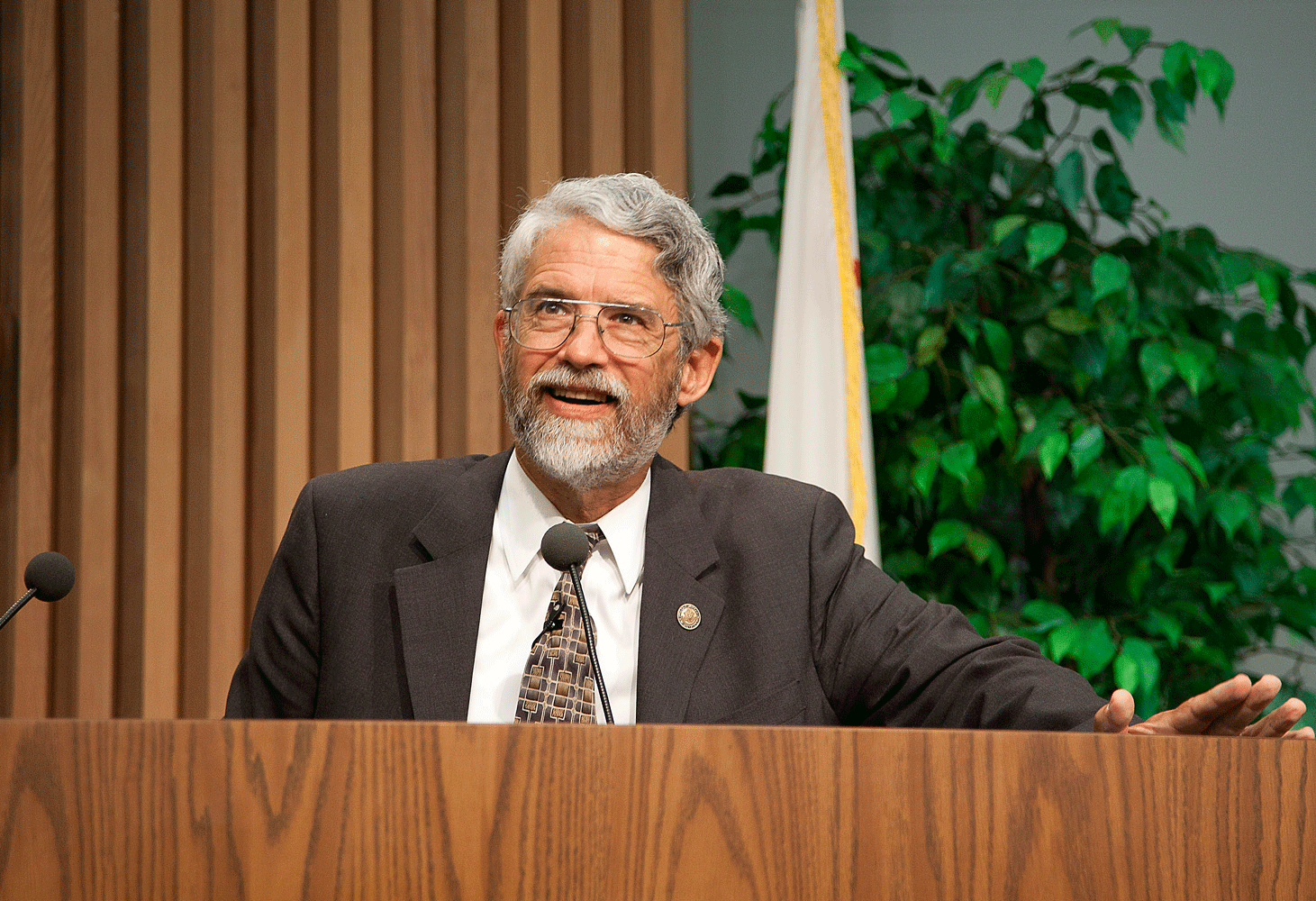
Presidential Science Advisor John P. Holdren (Photo: Lawrence Livermore Laboratory)
¬¬CURWOOD: It's Living on Earth, I'm Steve Curwood. In honor of the Earth Day season we turn to one of the most environmentally-conscious member of President Obama’s White House senior team, science advisor John Holdren. As America’s top scientist, Holdren has been instrumental in marshalling federal resources to understand and address climate disruption, and helping to establish a climate assessment program. I asked him about President Obama’s climate action plan which he helped to develop.
HOLDREN: Well, there are three components to the President's Climate action plan, and the first one is reducing carbon pollution in the United States. The second component is improving preparedness for and resilience against the kinds of climate changes that we’re not longer able to avoid. That is, providing the kinds of information to communities, to businesses, to individuals that will enable them to better prepare for and respond to climate change. The third component of the action plan is to increase our engagement with other countries in order to get their collaboration in a global approach to reducing greenhouse gas emissions as well as a global approach to increasing preparedness.
CURWOOD: Let’s talk about sea level. The National Climate Assessment draft report talks of a range of eight inches to six feet as the biggest range the report gives of sea level rise over the next century, and, of course, some of our biggest cities are on the coast - New York, Boston, Miami, New Orleans. What should those cities be doing now to prepare for rising seas, and how can the federal government help?

Dr. John Holdren is the Science Advisor to President Barack Obama. (Lawrence Livermore National Laboratory)
HOLDEN: Well, rising sea level is a problem for a number of reasons, and one in particular, is the extra damage done by storm surges on top of a rising sea level. We saw that already in the case of [Superstorm] Sandy. The ways that we can prepare: one, we need to understand where the vulnerability is going to be in terms of coastal flooding. We launched the first installment of our climate data initiative just a few weeks ago, basically providing datasets for decision-makers all around our coasts to know what’s coming. One of the things we would expect is that planners and developers would take note and would not construct new housing or new commercial space or other infrastructure in the areas that are most at risk of coastal flooding. Another thing we can do is invest in the protection of natural barriers - sand dunes, mangroves, wetlands of a variety of kinds - that help protect against storm surges when they occur.
CURWOOD: The National Climate Assessment also talks about thresholds, tipping points and surprises. What might be some examples? I know recently you issued a report about methane.
HOLDEN: Well, one of the concerns about methane, which is a very potent greenhouse gas, is that large quantities of methane are stored under the tundra, under the permafrost, and large quantities of methane in a form called methane clathrates or methane hydrates under shallow coastal seas. And there has been a concern that in a warming world, a very substantial quantity of methane might be released relatively rapidly. It’s one of many tipping points that are looked at in terms of the potential for unpleasant surprises.
Another tipping point would be if the warming of the southern oceans and other aspects of global climate change were to destabilize the west Antarctic ice sheet. That ice sheet contains the equivalent of about five meters of sea level rise, and so another tipping point that is at least talked about is the possibility that we can destabilize the ice sheet and encounter a much larger rate of sea level rise than is currently projected.
CURWOOD: So 2015 is going to be an important year for climate talks. The international community gets together in Paris. A new agreement will have to be adopted by all parties. As the President’s science advisor, what kind of preparations are you making for these negotiations?
HOLDEN: Well, we’re obviously having a lot of conversations among the President’s senior advisors in the White House and bringing in the relevant members in the Cabinet. All of these folks are sitting around tables and working out what the United States position should be going into the Paris talks, and, of course, we’re working very hard to make sure that the United States stays on track to meet the goal the President already announced of reducing US greenhouse gas emissions by 17 percent from their 2005 levels by 2020. Because after all, we’re going to be talking about targets going forward after the year 2020, and we better demonstrate that we can meet the early term targets in order to have the credibility to propose and push forward a longer term and more ambitious targets.

The US has pledge to reduce its carbon emissions 17% by the year 2020. (bigstockphoto.com)
CURWOOD: What would the agreement coming out of Paris have to look like to avert the worst affects of climate change in your opinion?
HOLDEN: The world really needs to be on a declining trajectory of greenhouse gas emissions after 2025. If greenhouse gas emissions are still growing post 2025. It is very unlikely that the world would be able to avoid exceeding the target of two degrees Celsius above pre-industrial levels that was agreed by the G-20 in 2009, and indeed, if we’re still growing after 2025, it will be a challenge even to stop at three degrees Celsius. Those numbers may sound small, but it’s important to remember that the Earth’s average surface temperature is a little bit like the temperature of the body. It’s really like an index of the state of the underlying system. If your body temperature went up three degrees Celsius, you’d know that you were having a serious problem, and similarly the world in terms of its whole climate system will be having a serious problem if we go to three degrees Celsius or more.
CURWOOD: Now the White House recently announced that it will again delay a decision on the Keystone XL pipeline which would bring the tar sands oil from Canada through the US to Gulf Coast refineries. This on the basis of litigation over the proposed route. What’s your opinion of the Keystone project and how does it fit into our need to reduce emissions.
HOLDEN: As the President’s science advisor, I reserve my opinion on controversial matters of that sort for the President.
CURWOOD: As the President’s science advisor, what concerns you most about our ecological systems? What keeps you up at night?
HOLDEN: Well, I would say the thing that keeps me up at night the most is the climate change issue, and the reason for that is that climate is the envelope within which all other environmental conditions and processes have to function. And if we distort that envelope enough as we are well on our way to doing, we imperil the functioning of all the other environmental conditions and processes on which human well-being depends. We’re going to change the distribution of species, both the ones we love and the ones we hate. We’re going to change the productivity of ecosystems. We’re going to change the chemistry of the ocean in ways that could imperil ocean fish production. So almost no matter what environmental problem you’re interested in, you better be interested in addressing the climate change challenge, and that’s why it has such a priority in the Obama administration.
CURWOOD: John Holdren is assistant to President Barack Obama and director of the Office of Science Technology Policy at the White House. Thanks so much for taking the time today.
HOLDEN: My pleasure. Thank you, Steve.
Related link:
National Climate Assessment Draft Report
[MUSIC: The Bad Plus “The Augers Of Spring” from The Rite Of Spring (Sony Music 2014)]
BP Says Gulf Cleanup Over
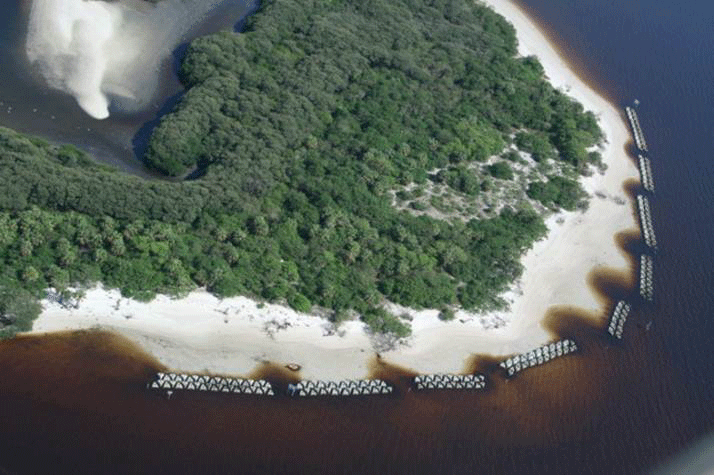
Breakwater construction projects are a tool for restoration of Alafia Banks, an Audubon sanctuary hosting 18 species of colonially-nesting waterbirds and seabirds in Tampa’s Hillsborough Bay. Restoration will reduce erosion, increase available nesting habitat, and improve water quality on a globally Important Bird Area. (Photos: National Audubon Society/ Audubon Florida)
CURWOOD: During April - Earth Month - we revisit some past stories to find out what developments there have been. On April 20, 2010, BP’s Deepwater Horizon well exploded, killing 11 workers, and eventually gushing over 200 million gallons of oil into the Gulf of Mexico. Soon after the blow-out, a Sky News reporter asked BP’s CEO Tony Hayward what effect he thought the oil would have on the Gulf of Mexico.
HAYWARD: I think the environmental impact of this disaster is likely to have been very, very modest. It is impossible to say and we will mount, as part of the aftermath, a very detailed environmental assessment but everything we can see at the moment suggests that the overall environmental impact of this will be very, very modest.
CURWOOD: Well, many researchers along the Gulf coast did not believe Mr. Hayward was right.
And back in 2010, Living on Earth’s Jeff Young visited the coast of southern Louisiana to check out the reality.
[SOUNDS OF SURF]
YOUNG: Grand Isle is about as far south as you can get in Louisiana by land—or what’s left of the land, anyway. Erosion and subsidence have melted miles of the surrounding marsh into open water. But this is still crucial bird habitat and an important time for birds—breeding season.
DRISCOLL: There are least terns mating. That would be normal breeding season behavior.
YOUNG: Melanie Driscoll has binoculars pressed to her eyes—as she often does. She directs Audubon’s Louisiana program.
DRISCOLL: They’re just toward the edge of the water, it’s a very quick event—it’s over already.
YOUNG: They’re not big on afterglow, are they?
DRISCOLL: [LAUGHS] Bird copulation is a fairly short-lived event without a lot of ceremony, usually.

Black Skimmers chasing during courtship, Raccoon Island, LA (photo: National Audubon Society/Melanie Driscoll)
YOUNG: The male tern flies back to his mate with a gift—a small fish. In a normal year this would be a happy time and a happy scene for Driscoll, watching resident species take to the nests and thousands of migrants pass through. But this is not a normal year. The long line of bright orange oil booms just offshore reminds us. The dozen or so oil platforms on the horizon remind us. And everything about the terns’ little love scene here now seems loaded with danger—is the oil in the water here? Is it in that fish he just caught?
DRISCOLL: They don’t get any warning. They eat the food, they drink water of the Gulf and they are driven to breed where they’ve bred before, whether that habitat is disturbed or not just affects their success, not their drive to breed here.
YOUNG: There are globally important bird areas in these marshes and barrier islands. And some are now taking oil. Driscoll is here to keep tabs on what is likely to be a grim toll. The oil is slowly taking effect just as many birds are most vulnerable. She takes meticulous notes on the sanderlings, turnstones, redknots, brown pelicans. The point is not just to look for oiled or dead birds, but to detect the absence of birds.
DRISCOLL: Because birds will die undiscovered we are less reliant on a body count in this spill because it is so different than eventually a change in abundance, a change in numbers.
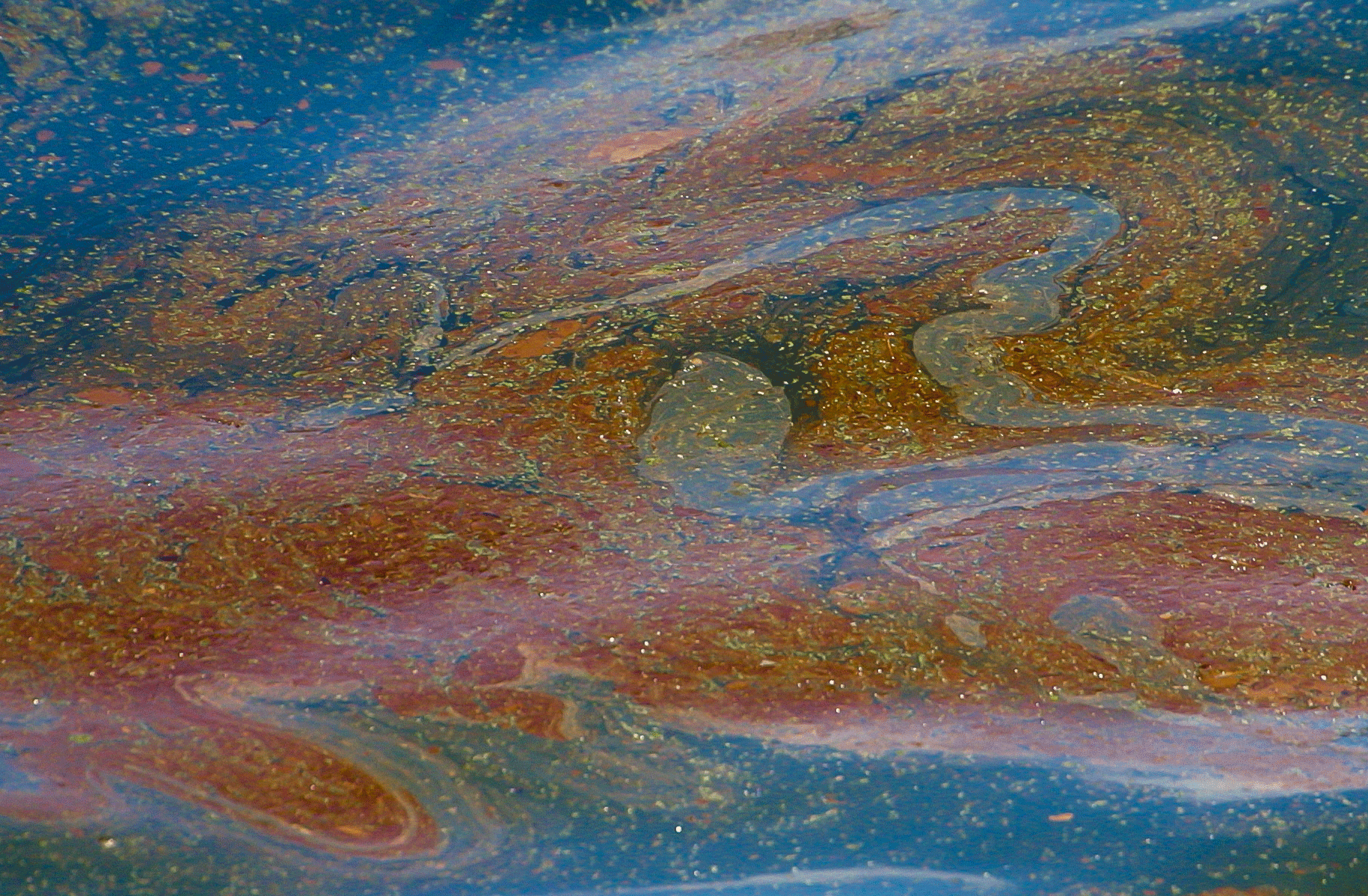
Oil on water after the BP spill from 2010 (photo: National Audubon Society/Melanie Driscoll)
YOUNG: So you might not know what’s really going on here until next year?
DRISCOLL: We likely won’t know for a year for some species. Others species, many birds, of northern gannets, particularly young, stay out in Gulf for a couple of years until they reach breeding maturity. If those birds are dying it may be three or four years before we notice a change in the nesting population.
YOUNG: It’s so complicated the interaction of things here. As a layperson your impression is well, is there oil on the bird? No? Well, okay! But there’s a lot more to it than that.
DRISCOLL: There’s a saying about ecology that it’s not rocket science, it’s a lot more complicated than that. We’re looking at a system. The birds rely, not just on their feathers insulating them, they rely on food chains that are underwater or in the sand, they rely on protection from predators by being familiar with their surroundings—it’s very complicated.
YOUNG: And it gets more complicated. Several fish stocks in the Gulf were already in serious decline. The mouth of the Mississippi already sees a massive dead zone of low oxygen each year. The land is already slipping into the sea. And now comes the oil. Driscoll wonders how much the ecosystem can take.
DRISCOLL We don’t know. We’re playing roulette with these Louisiana marshes. They’re under many, many threats. They’re in a working landscape and that puts them at more risk for oil and gas spills. We don’t know. This fragile systems are very productive. There’s a threshold; you might have increased productivity before a crash. We’re afraid of the crash. We don’t know what will be the tipping point. The oil makes that tipping point probably closer.
YOUNG: Driscoll and other scientists and conservationists in the region are settling in for a long haul effort. Stopping the gushing oil in the Gulf may be a race, but understanding the ecological impact is a marathon.
[SOUNDS OF SURF]
CURWOOD: Well, four years later, BP has announced that it’s ending the “active cleanup” from the spill, even though US Coast Guard officials argue that the job’s not finished. And to find out how the birds in the Gulf are faring today, we called up Audubon’s Melanie Driscoll again. She says oil is still washing up on the Louisiana's beaches.
DRISCOLL: Where the oil was heaviest we still see it fairly frequently, places like Grand Isle where we spoke four years ago, it occurs after summer storms, hurricanes and other high tides.
Sometimes that's little tar balls, but last June a 40,000 pound mat of tar rolled up onto East Grande Terre Louisiana. There are hundreds, thousands of pounds of oil left in the system, and some of those will continue to come up onto our beaches.
CURWOOD: What is the state of the Gulf of Mexico today? How is the ecosystem doing?
DRISCOLL: We know from some of the science done since the oil spill that there are some ecological effects from the spill. We know that some deepwater corals near the spill site have been killed. We’ve seen things like oil accumulated in the tissues of eggs in birds like the American White Pelican and the Common Loon, and that shorebirds have been less successful foraging in areas where the cleanup activities caused continued disturbance. We expect that there will be studies eventually that show that hundreds of thousands of birds were killed during the acute phase of the disaster, but the challenge is that, at this time, the studies are tied up in the natural resources damage assessment. What scientists know is held within that legal process to prosecute the responsible parties, and so the government can’t talk about what’s really going on with the Gulf ecosystem, and independent conservation organizations can’t appropriately help guide responses because a lot of the studies are not available at this time. From other spills, we know that acute toxicity mutations, egg failure, reduced nestling growth, reduced reproduction and survival can plague birds in spill impact areas, and this was a very big spill impact area.
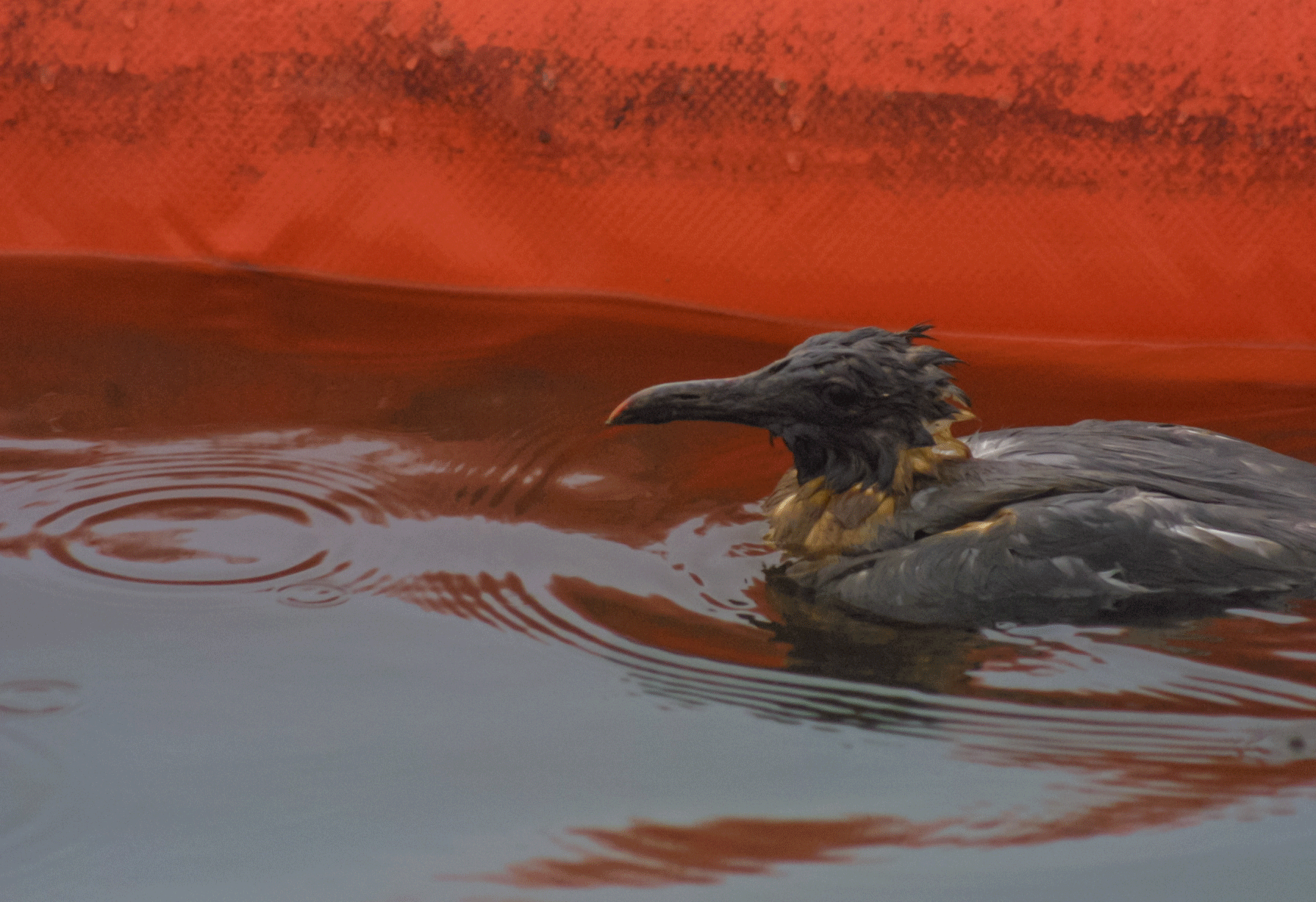
Oiled Laughing Gull, Barataria Bay, LA. Bird was eventually rescued, rehabilitated, and released (photo: National Audubon Society/Melanie Driscoll)
CURWOOD: Back when you spoke to Jeff Young, you said that we wouldn’t know the impact of the spill on bird populations for a few years. We’re four years on. Overall, how are the birds doing?
DRISCOLL: It’s a little difficult to say. We go out to nesting islands, and we see a couple of different things. Out in Barataria Bay and Bay Jimmy where the oil came in very heavily, some of the islands like Queen Bess have what seem to be thriving populations of pelicans and Roseate Spoonbills, terns and egrets. Other islands where the birds were nesting during that fateful summer of 2010, the islands are completely gone or they are so small that there’s no room for birds to nest. And if they dared to try, their nests would be over-washed in the first summer storm. So those birds had to go somewhere, and, we don’t have really good tracking available to know where those birds have gone or if they’re breeding successfully somewhere else.
CURWOOD: What happened to the islands. Why did they go away?
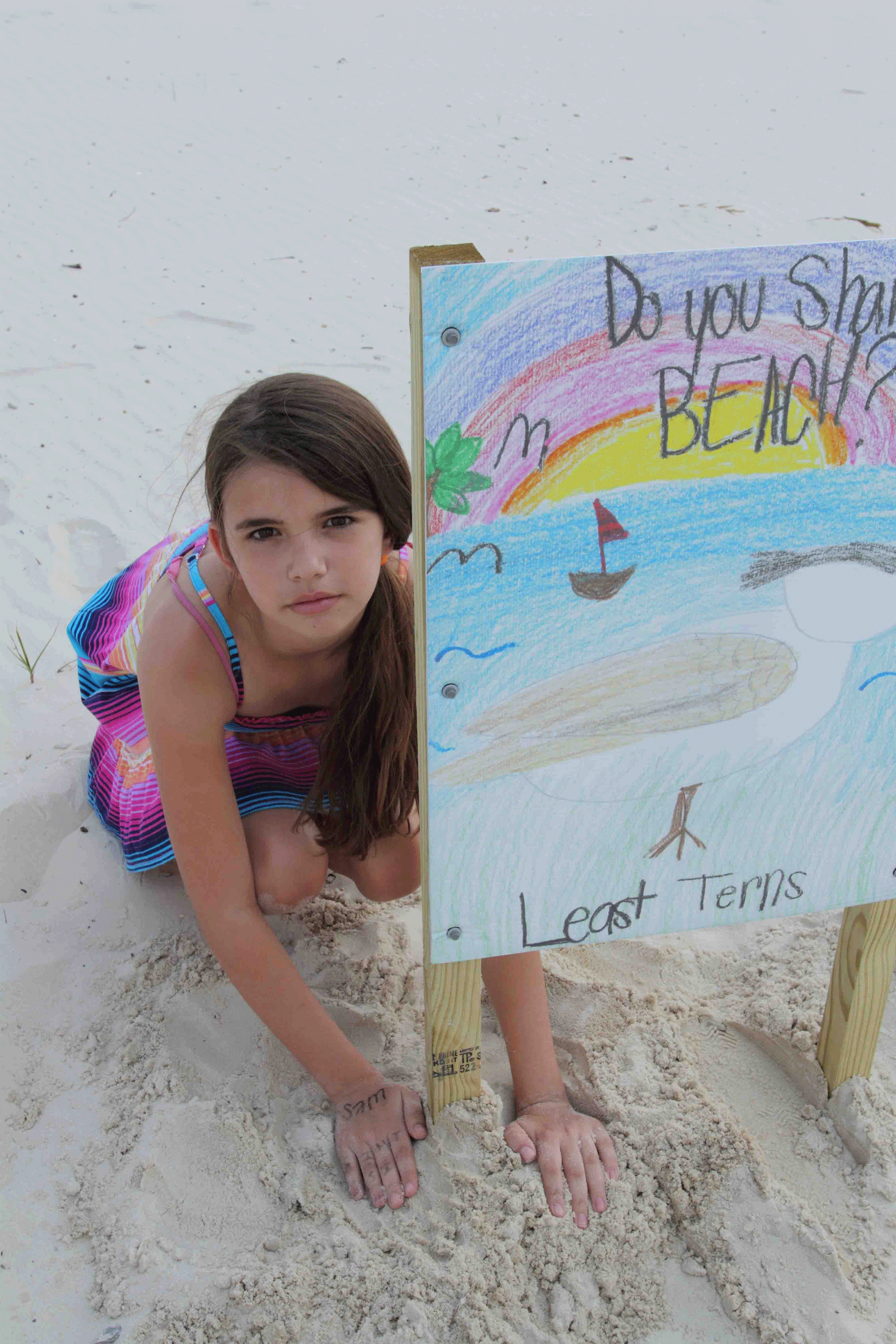
Schoolgirl in Mississippi helping install sign she created to encourage beachgoers to share the beach with nesting Least Terns. An effective and tested strategy to reduce disturbance, engage communities, increase nesting success and improve populations of birds harmed during the DWH disaster. (Photo: National Audubon Society/Mozart Dedeaux)
DRISCOLL: The islands were in a bay in which they were already eroding, and they were eroding fairly quickly, but some of those islands were covered with thick lush mangroves that were the nesting sites for the Brown pelicans. Oil, when it heavily coats marsh grass or mangroves, can suffocate the roots, and the root systems are really what holds this sediment together. They hold the sand in place and allow there to be land out there in the middle of the Gulf. The mangroves are dead. It actually looks like a little miniature tree graveyard out on one of the sites. It’s just stark brown branches where thriving green mangroves coated an island. As the roots have died, the erosion has either increased or continued and there’s virtually nothing left now. This is again the challenge in that all of the science being done or most of it is held within a confidential process. All I can say is I’ve never seen mangroves die this quickly and the erosion seems to be very high. I can’t say that’s attributable to the spill. It’s just very suspicious that this would be happening at that rate.
CURWOOD: So it’s almost a quarter century ago that the Exxon Valdez spill occurred, and it’s still impacting the ecosystem there in Prince William Sound in Alaska. How long before we will really know the scope of the damage that was gone to the Gulf of Mexico by the Deepwater Horizon Disaster?
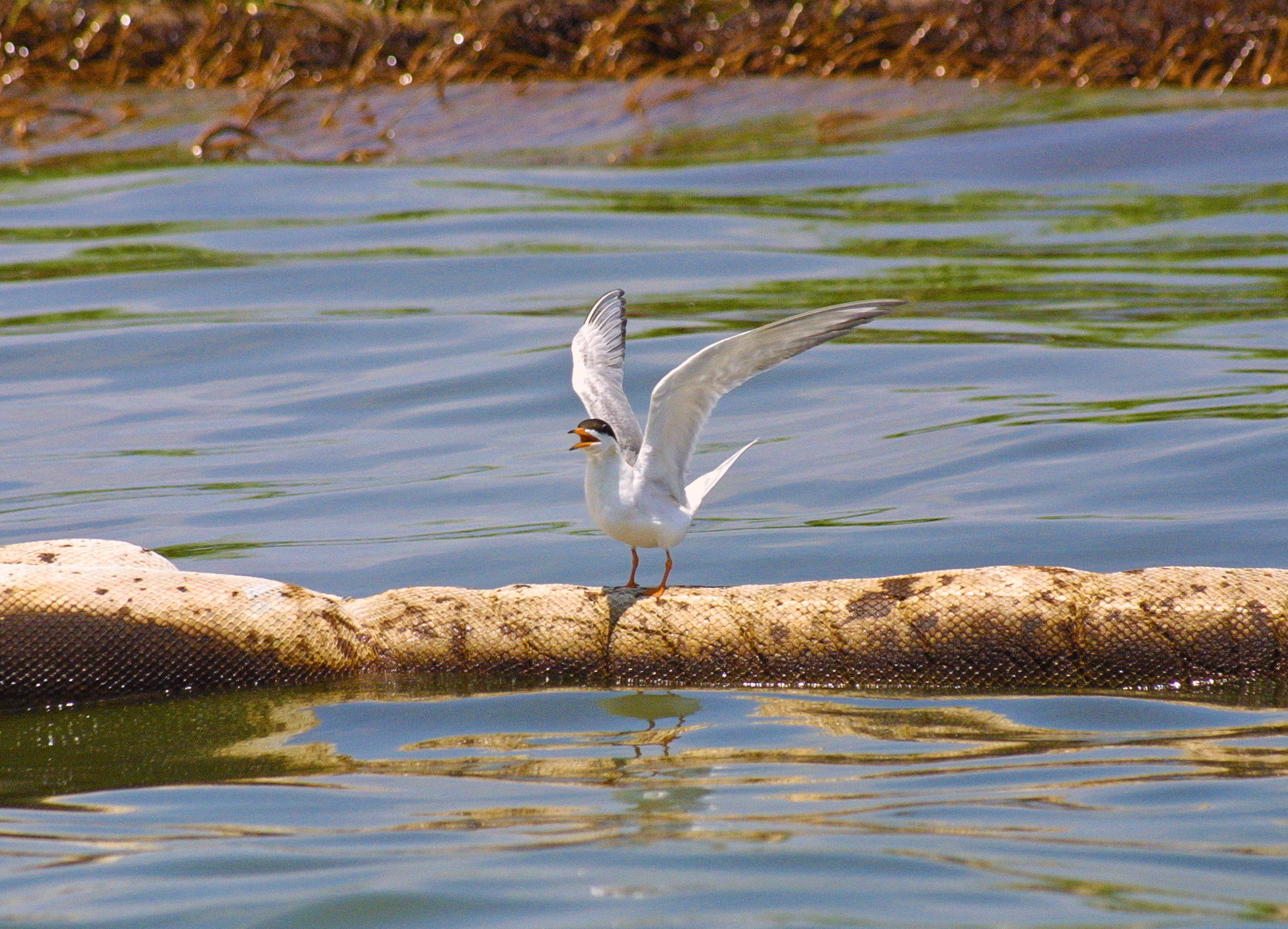
Forster’s Tern perched on oiled boom, with oiled marsh in background in 2010 (photo: National Audubon Society/Melanie Driscoll)
DRISCOLL: Like with the Exxon Valdez, I think we’ll know parts of it in the next few years, but it will be decades until we know the full toll. The Pigeon Guillemot is the bird species that has struggled the most to recover from the Exxon Valdez spill. Many thousands died in Prince William Sound during the disaster, and since then they have faced problems both in the food that the adults eat, and in the Pigeon Guillemot becoming a favored prey of mink and river otter, when the shellfish prey of the mink and river otter was compromised by the spill. Because of the increase of a variety of threats, the Pigeon Guillemot population in the Prince William Sound has never recovered.
As Also Leopold stated, “To keep every cog and wheel is the first precaution of intelligent tinkering.” We, as humans, are really not wise enough to randomly tug at strands in the web of life, and then to predict which tug should cause a link to break. It puts us in the position now of needing to study, to monitor, to steward, and restore and to hope that in doing so we’re able to support the populations damaged by this spill even if we can’t say yet which of those populations are most critically damaged.
CURWOOD: Melanie Driscoll is the Director of Bird Conservation for the Gulf of Mexico and the Mississippi Flyaway for the National Audubon Society. Thanks for taking the time with us today, Melanie.
DRISCOLL: Thank you, Steve, it’s been a pleasure to be here.
Related link:
Check out Melanie Driscoll at Audubon
[MUSIC: Pat Metheny “Born” from Kin (Nonesuch Records 2014)]
Update - Fighting to Protect an Ancient Underwater Forest
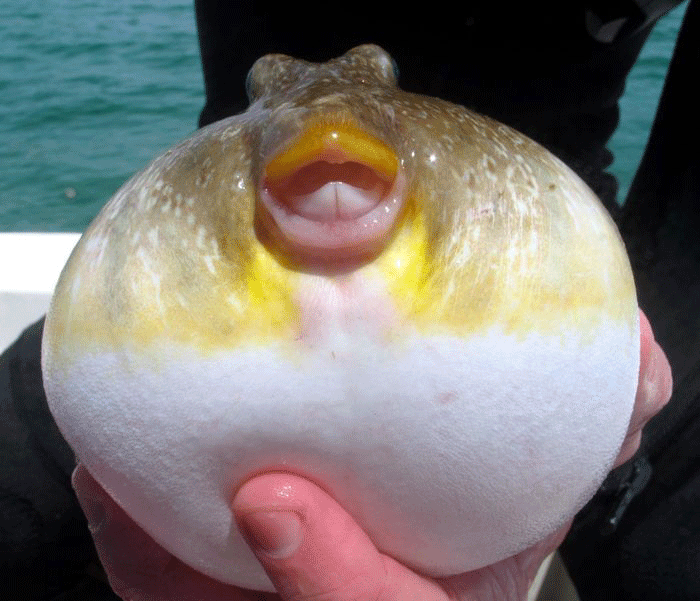
A pufferfish from the site (photo: Ben Raines)
CURWOOD: It's Living on Earth, I'm Steve Curwood. When we last spoke with Ben Raines of the Weeks Bay Foundation in Alabama about a year ago, he told us an amazing story about an underwater woodland off the coast of Alabama. A local fisherman had discovered a mysteriously fishy patch of ocean, and when divers checked it out they found a forest of ancient cypress stumps on the ocean floor. Since then, Ben has been collaborating with scientists to study the submerged trees, and working on a documentary about it. He joins us now from Fairhope, Alabama. Welcome back.
RAINES: Hey, thanks for having me back.
CURWOOD: So, Ben, remind us about this forest. What does it look like?
RAINES: Well, there’s an ancient river channel that meanders through the site, and you just see all these logs laying all over the bottom and then stumps projecting up off the bottom. When you get closer and start looking, the logs still have bark. We’re actually finding trees that have lightning scars on them. They’re just incredibly well preserved, and it’s just this magic sort of place that you swim through realizing that you’re traveling back in time 50,000 years.
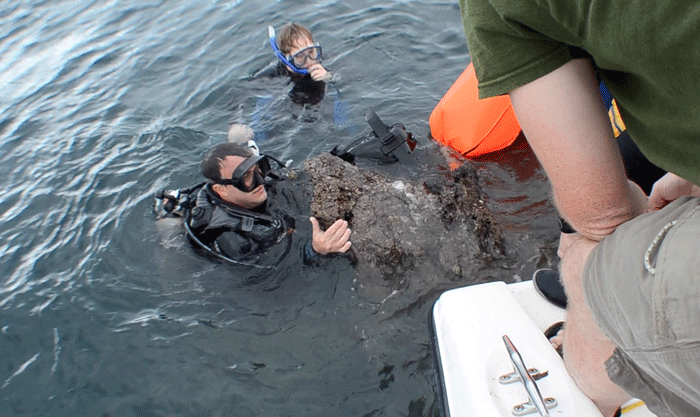
Divers pull up stumps to be examined (photo: Ben Raines)
CURWOOD: Now, you’ve been working with scientists who’ve been studying this forest over the past year. What have you learned since we last spoke?
RAINES: Well, we’ve learned that some of the individual trees may have been as old as 2,000 years before they died. So these were like redwoods. We’ve got stumps down there that are up to ten feet across, and you don’t see trees like that on the Gulf Coast, and you can’t really imagine them, but before we were here cutting everything down, that’s what was here, just this forest of trees so big, ten people with their arms outstretched couldn’t fit all the way around it holding hands.
CURWOOD: So remind me about what science tells us about the age of this forest again.
RAINES: Well, if you just look at the depth, you would think that it should be about 12,000 to 14,000 years old, but then when we did the actual radio carbon dating, which was done at Lawrence Livermore National Laboratory, they did it three times because they were so puzzled...it came back radio carbon dead which means older than 50,000 years. So what they believe has happened is as Louisiana has gotten heavier over the eons with mud coming down the Mississippi River, weighing down the delta over there, it’s caused the bottom over here to rise up like a bulge, you know, like if you squeeze a balloon it gets bigger in another spot. So the depth here doesn’t appear to be accurate as far as how old the forest is. So now we’re having some uranium dating done of the trees, and that’s going to be done in Taiwan, and it’s a whole new technique, so hopefully we’ll get a very accurate date for when the forest was dry land.
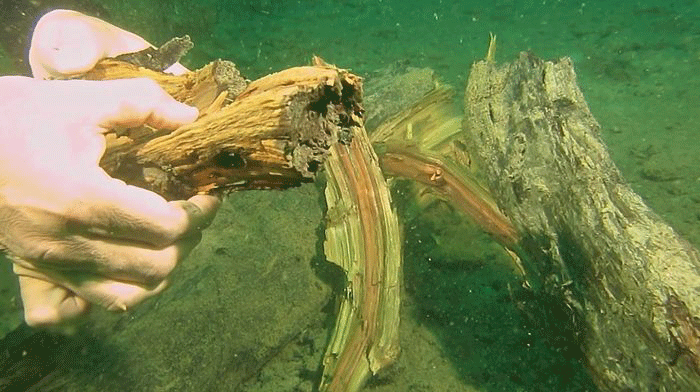
The wood was preserved for thousands of years buried in sediment (photo: Ben Raines)
CURWOOD: But at this point, it’s something more than 50,000 years.
RAINES: Right. And that’s about as precise as we can get right now.
CURWOOD: What’s the latest theory as to how this forest got there? What was the accident in nature that preserved this whole thing?
RAINES: Well, we’re still working on that a little bit, and when we get a more precise date, we may be able to tie it to some sort of event, like a meteor or something like that. The other possibility is a big hurricane. Sea levels were coming up and it may have just shifted sediments enough to bury this stuff, and so once things get covered up, they get protected from oxygen. There’s no decay. So these trees were essentially entombed while they were living, and everything below the oxygen level is still there. That’s why all the trees look like they were cut off at the same height, and when you cut into them with a saw, they still smell fresh like fresh, piney trees and they have sap that oozes out of the cuts.
CURWOOD: So, they’ve been preserved all this time. Why are they exposed now?
RAINES: Well, Hurricane Ivan in 2004 had 90-foot waves, some of the biggest waves ever recorded in the Gulf of Mexico. And we believe one set of these giant waves came through this area and just scoured out about five or six feet of sand and revealed the stumps.
CURWOOD: Now, when we last spoke with you, you were concerned that furniture companies, perhaps guitar companies, would come looking for this forest. What’s happened on that front?
RAINES: Well, you know, the forest kind of went viral last year, and that’s how it came to y’all’s attention, and all these salvage companies started calling and offering to buy the coordinates to the site. Because they wanted to go dig them up, exactly like you said. So we decided to push to have it turned into a national marine sanctuary. We’ve actually made a great deal of headway, and I believe, NOAA, the National Oceanic and Atmospheric Administration, is going to make it a sanctuary where you’ll still be allowed to fish, and you’ll still be allowed to scuba dive, you just won’t be able to steal the stumps off the bottom.
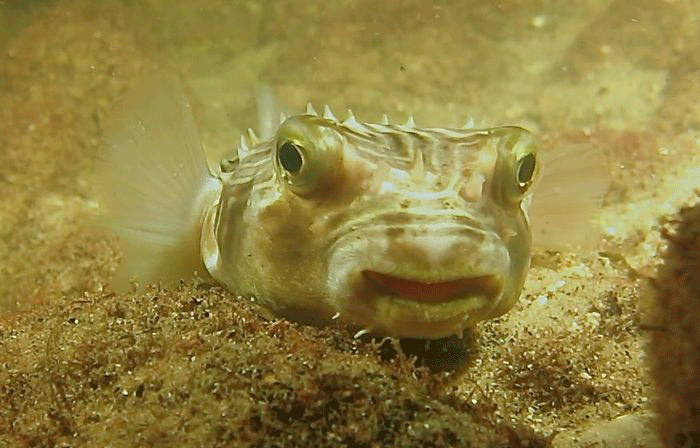
Many different fish species find shelter among the underwater stumps (photo: Ben Raines)
CURWOOD: What other steps are you taking to protect the forest?
RAINES: Well, raising awareness...we started making a documentary, and so we assembled a little film crew and we have a team of scientists that go out there with us, and we’ve been shooting for about a year. And hopefully, we’ll have something finished by the end of the summer. We think that may go further than anything else, kind of bringing people to it, showing them that it’s...you know, it’s like the Grand Canyon, it’s a natural wonder, and if we pull it up off the bottom, it’s over, it’s gone.
CURWOOD: To what extent have you been able to keep the coordinates of the forest a secret?
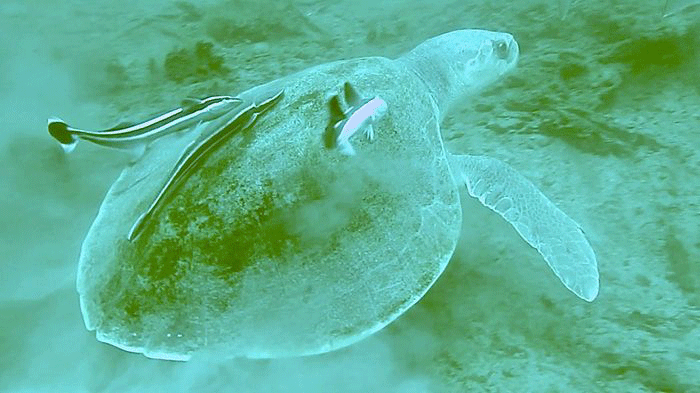
The endangered Kemps’ Ridley sea turtle has been spotted in the forest (photo: Ben Raines)
RAINES: Well, we’ve actually protected them. I still haven’t given them to the government agencies yet with the understanding that they’ll get them when they come see the forest, and we’re trying to keep them out of the public record so very few people have them right now. We only visit the site on weekdays so that no one can idle up next to us and steal them. So far, I’ve never seen them published on the internet or anything like that, but, of course, with any secret, it’s a matter of time. So we feel like the clock is ticking, and we need to get it protected before the numbers get out because right now there’s no law that would prevent a company from pulling a stump up off the bottom if they knew where they were.
CURWOOD: Sea level rise, of course, is a huge problem that faces a number of coastal communities around the world right now. What does this forest teach us about nature, climate change, sea level rise?
RAINES: Well, whatever the cause of sea level rise and climate change, this is proof positive it happens, and it happens quite dramatically. [LAUGHS] You come up off the bottom from seeing these stumps, and you stare into the distance and you can see all these oil and natural gas platforms and these high-rise condos on the beach, and it sort of reminds you that they’re all going to be underwater eventually. You know, you go 100 miles inland in Alabama and along the Gulf Coast, you find shark teeth and whale bones because that was all part of the ocean at one time.
CURWOOD: Ben Raines is the Director of the Weeks Bay Foundation. Thanks for taking the time today, Ben.
RAINES: Thank you all very much for having me on.
Related links:
- Watch the trailer for Ben Raines’ documentary about the underwater forest
- Original Living on Earth July 2013 story on the underwater forest.
[MUSIC: Underwater Forest: Captain Beefheart “When I See Mommy I Feel Like A Mummy” from Shiny Beast (Bat Chain Puller) (Warner Bros 1978)]
Beyond the Headlines

Monitoring the radiation levels at Chernobyl (photo: Michael Forester Rothbart)
CURWOOD: Let’s come up from under the waves now, and head to Conyers, Georgia, for our weekly trip beyond the headlines with Peter Dykstra. He's the publisher of Environmental Health News -- EHN.org and DailyClimate.org and joins us on the line. Hi there, Peter.
DYKSTRA: Hi, Steve. I’ve got a tourism story for you like no other. It’s from the Newsweek writer named Alexander Nazaryan. He took a little excursion recently, on the company dime, to a fast-growing tourist destination in a country where you wouldn’t expect to see growing tourism.
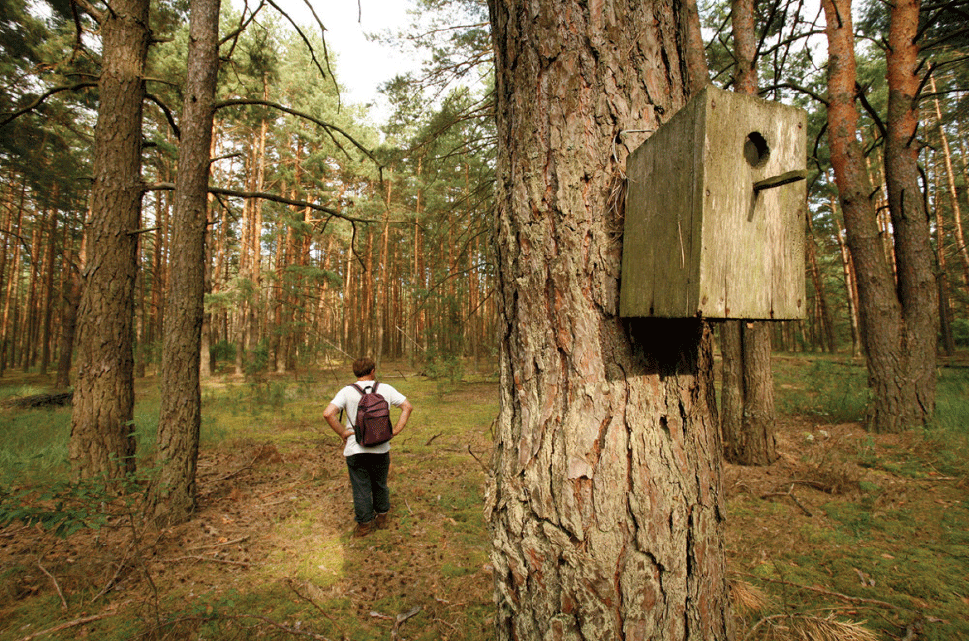
The empty forest around Chernobyl (photo: Michael Forester Rothbart)
CURWOOD: And that country would be?
DYKSTRA: The Ukraine, our most recent global flashpoint, the place where the old Cold War may start to be re-enacted, but one of the Ukraine’s most famous gifts from Russia is starting to draw a crowd, and that gift is none other than the Vladimir Ilyich Lenin Atomic Power Station, better known to the world as Chernobyl.
CURWOOD: I suppose it is a “hot” destination...

Many people advocate for building solar arrays on top of Superfund sites (photo: bigstockphoto.com)
DYKSTRA: Well, yeah. The Ukranian government...it’s not entirely off limits...there’s tourism around, not in, the Chernobyl plant. They started offering limited access to Chernobyl about a decade ago, despite the fact that there are serious radiation risks, and that those risks will persist long after we’re gone. In 2004, they drew about 800 tourists, but this year, one Kiev-based travel outfit says they’ll take about 12,000 people to the ruins.
CURWOOD: It still sounds a little crazy.
DYKSTRA: Yeah, I don’t disagree, but this is a great story. Alexander Nazaryan, the writer, describes walking around Pripyat, that’s the ghost town that used to have 49,000 people in it, most of them involved in running Chernobyl. Some places are off limits, you always have to carry a dosimeter there, and obviously, you don’t stick around too long, and the guest cottage where they put you up advises you to remove your radioactive shoes before going inside.
CURWOOD: So with all the turmoil and anguish in the Ukraine, one of the things that’s thriving is the ghost town at Chernobyl.
DYKSTRA: Yeah, and whatever you think of Vladimir Putin, don’t ever say that Russia has never given the Ukraine anything. Next story?
CURWOOD: Sure.

A family in Chernobyl (photo: Michael Forester Rothbart)
DYKSTRA: The Reilly Tar and Chemical Company, on the southwest side of Indianapolis, they refined coal tar and treated wood products for decades, they closed down in 1972 and left a big enough mess that it became a 120-acre Superfund site. It was an eyesore when it closed, a patch of land whose only use was a storage lot for truck trailers, of course, that didn’t make it any less of an eyesore.
CURWOOD: And I take it we had some kind of re-birth where the Princess kisses the Frog?
DYKSTRA: Well, not quite, because science tells us that neither Princesses nor frogs tend to hang out or thrive at Superfund sites contaminated with things like creosote, benzene, and pyridine. But what did happen is that the company that inherited the abandoned property stuck up a partnership with a solar company, that brought in the EPA, local government and the local utility to take about a third of the site and turn it into a solar farm: 43 acres of solar panels. EPA’s been involved in converting several Superfund sites into solar farms, this is the biggest one yet, and they have plans to triple the size of this one and cover most of the former Superfund site.
CURWOOD: So unlike Chernobyl, it looks like a happy ending.
DYKSTRA: Well, in fairness, you may eventually have a happy ending at Chernobyl, but we’ll have to wait thousands of radioactively miserable years to find out.
CURWOOD: So, tell me, Peter, what’s on the history calendar this week?
DYKSTRA: Well, Steve, when you deal with science on anything, generally you don’t start with a 38-year-old magazine piece, right?
CURWOOD: Yeah, that’s generally not how science works, and, for that matter, that’s not how journalism usually works either.
DYKSTRA: Well it’s time to wish a happy 38th birthday to that infamous Newsweek Magazine story on global cooling. Time Magazine did one back then, too, and back in the 1970s there was some speculation that we were entering a cooling period. Even big-brained thinkers like Buckminster Fuller took it seriously.
CURWOOD: Yeah, but I don’t think most of the science community took it all that seriously.
DYKSTRA: Correct, and this is 38 years ago...we were still in Vietnam, I was still in high school, and yet this is now still a major talking point for climate science deniers. Back in January of this year, one of our contributors, Doug Struck, went and tracked down the guy who did that Newsweek story 38 years ago. The reporter gave us a very reporter-like answer and said he stands by the story to this day, based on what he knew then, but he also admitted to being astounded that a 38-year-old magazine piece about global cooling is still being talked about.
CURWOOD: You mean like you and I are, now, thirty-eight years later?
DYKSTRA: OK. Yeah. Busted. So maybe I shouldn’t have brought it up.
CURWOOD: Peter Dykstra is Publisher of Environmental Health News, that’s EHN.org and the DailyClimate.org. Thanks so much, Peter.
DYKSTRA: Thanks a lot, Steve, we’ll talk to you soon.
CURWOOD: And there’s more on these stories on our website LOE.org.
Related links:
- Living on Earth’s Bruce Gellerman documentary about his visit to Chernobyl in 1996.
- Listen to this Living on Earth 2103 conversation with Michael Forester Rothbart about his experience visiting Chernobyl
- Read about the famous Newsweek global cooling article on the Daily Climate
[MUSIC: Larry Coryell “Clear Skies” from The Lift (Wide Hive records 2013)]
Earth Day Haiku
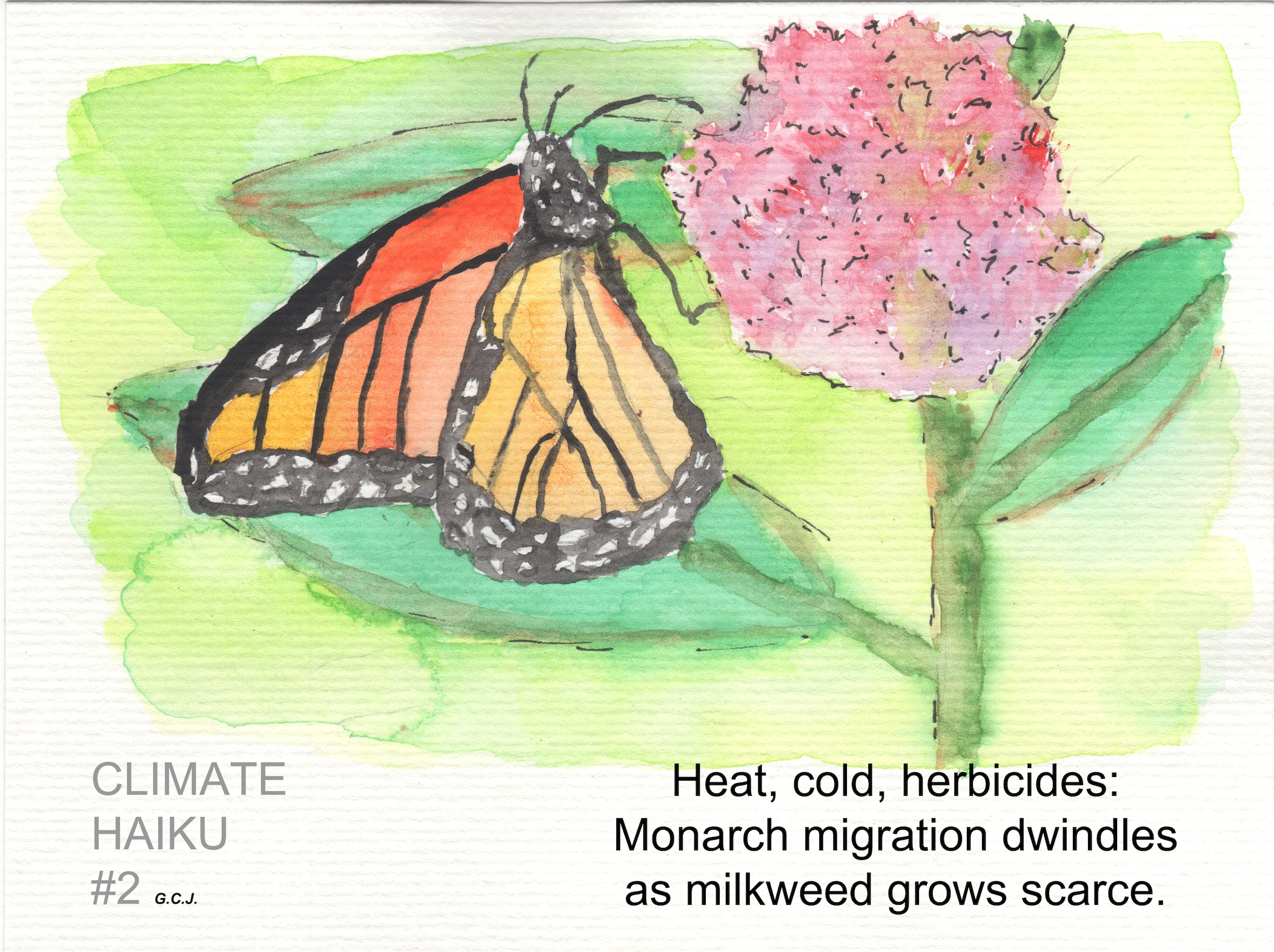
(Gregory Johnson)
CURWOOD: It was NOAA oceanographer Gregory Johnson who kicked off our April poetry requests when he crystallized part of the UN climate science report into haiku. He sent in some more haiku specifically for Earth Day, and so did his mother, Joyce Johnson of Falmouth, Massachusetts, who writes:
Earth Day is the time to come to aid the Monarchs. Plant milkweed seeds now.
She wasn't the only one with stern instructions. On our website, for instance, Patti Linder-Dodd wrote:
Rusty tin sits spoiled Staining the view for us all Pick up already!
Some of you were more philosophical...
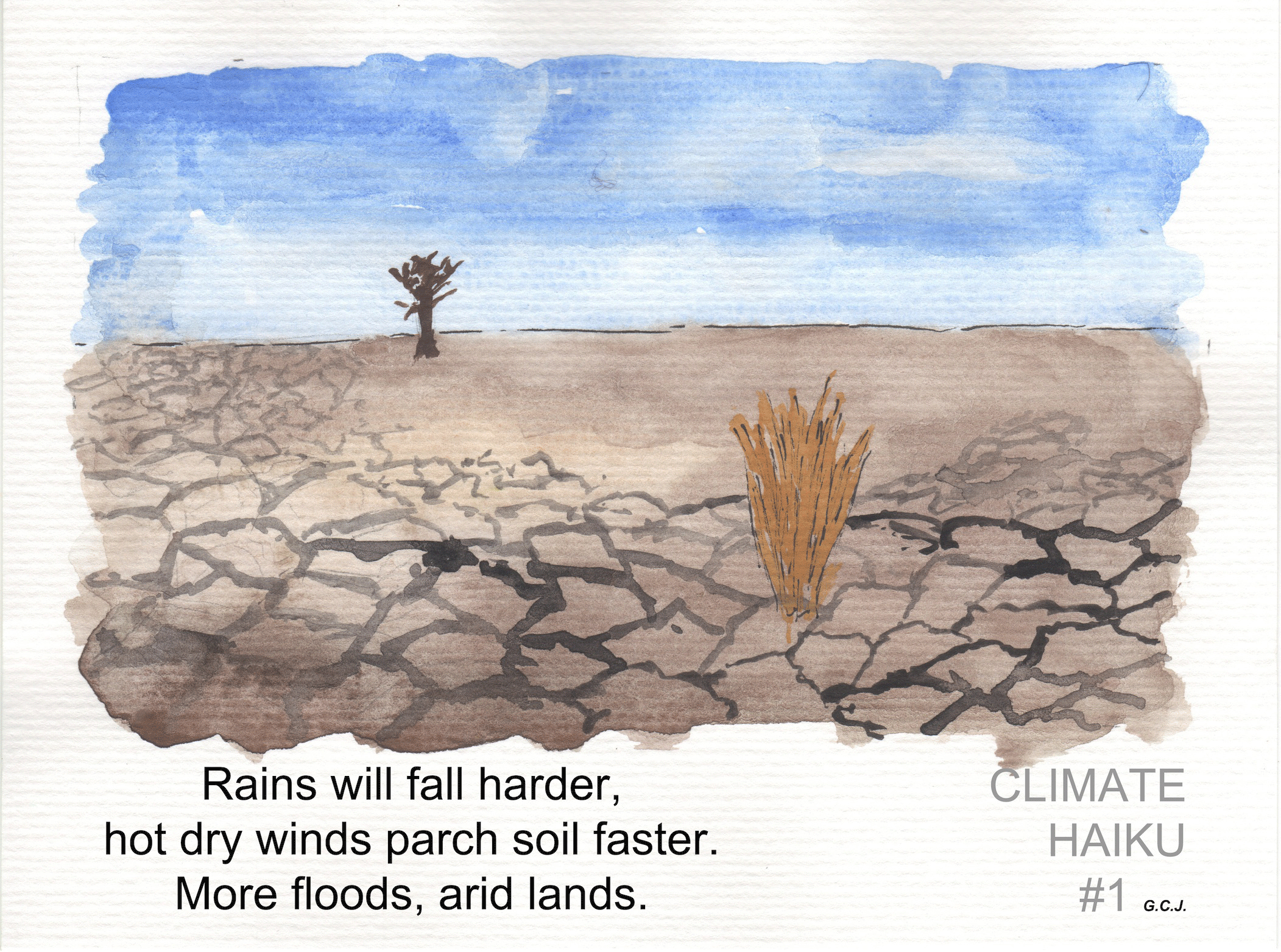
(Gregory Johnson)
DENTON: My name is Christopher Denton. I am a practicing real estate attorney in a little upstate city in New York called Elmira, New York. And I write poetry on my own, and I said, “You know, I’ll think about this. Maybe I can write something.” I’m always thinking about the environment, matters of land. So it was pretty easy to pop out.
Earth is mineral Man is biological All is chemical
CURWOOD: And we liked Bridget Carroll's thoughts as well, she wrote:
Environment. One
Syllable short. One mention
Not nearly enough.
CURWOOD: We agree. Not nearly enough, and poetry has the power to express deep thoughts in very few syllables.
EMERICH: I'm Carol Emerich, I'm a retired elementary school teacher, and I’ve lived and worked in the Santa Clara Valley, once known as the Valley of Heart’s Delight before it became known as Silicon Valley, all of my life. We’re in high spring really, edging towards summer, and all the spring colors are out and it’s quite beautiful. We’re in the middle of drought though which is a rather frightening drought. So any spring colors, flowers, greens...we’re celebrating.
I sing spring colors green stalks hold bright pink blossoms. They will not stay long.
And my second one:
Every earthly thing renews itself in springtime. For how much longer?
CURWOOD: Our final words today come from Eric Black who we reached on a rather scratchy line in Pittsburgh.
BLACK: For the climate deniers, this haiku:
Drought where it should rain. Super-storms setting records. It IS climate change.
CURWOOD: We have many more of your haiku. Thank you all. And we'll post as many as we can on our website LOE.org. And remember, we're always glad to hear from you - so get in touch at comments@loe.org. Once again, comments@ LOE.org. Or you can use our postal address it's PO Box 990007, Boston, Massachusetts, 02199. Or call our listener line at 800-218-9988. That’s 800-218-9988.
Related link:
UN Climate Change Reports As Haiku
[MUSIC: The Crusaders “A Ballad For Joe (Louis) “ from Southern Comfort (Verve Music Group 1974)]
Living on Earth wants to hear from you!
Living on Earth
62 Calef Highway, Suite 212
Lee, NH 03861
Telephone: 617-287-4121
E-mail: comments@loe.org
Newsletter [Click here]
Donate to Living on Earth!
Living on Earth is an independent media program and relies entirely on contributions from listeners and institutions supporting public service. Please donate now to preserve an independent environmental voice.
NewsletterLiving on Earth offers a weekly delivery of the show's rundown to your mailbox. Sign up for our newsletter today!
 Sailors For The Sea: Be the change you want to sea.
Sailors For The Sea: Be the change you want to sea.
 The Grantham Foundation for the Protection of the Environment: Committed to protecting and improving the health of the global environment.
The Grantham Foundation for the Protection of the Environment: Committed to protecting and improving the health of the global environment.
 Contribute to Living on Earth and receive, as our gift to you, an archival print of one of Mark Seth Lender's extraordinary wildlife photographs. Follow the link to see Mark's current collection of photographs.
Contribute to Living on Earth and receive, as our gift to you, an archival print of one of Mark Seth Lender's extraordinary wildlife photographs. Follow the link to see Mark's current collection of photographs.
 Buy a signed copy of Mark Seth Lender's book Smeagull the Seagull & support Living on Earth
Buy a signed copy of Mark Seth Lender's book Smeagull the Seagull & support Living on Earth

